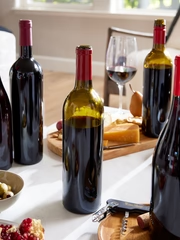A few weeks ago, we discovered in more detail the influence that oak had on wine. The storage of wine has been changing over the past millenniums. New technologies, vineyard expansion and the increase of worldwide wine production has given birth to some interesting concepts in the field of storage for wine.
When I worked at Petrus in the French wine region of Pomerol, I worked with square concrete tanks. They were bulky, not as shiny as stainless steel and difficult to work with. Yet, as you make your way around the cellar and discover more of the world of winemaking, you start to learn about heat exchange and heat transfer that concrete provides. You also learn that the ratio of skin contact with the must (grape juice) provided by square concrete tanks, is probably the best in the business. Basically, you cannot judge a book by its cover.


The new cellar of Chateau Cheval Blanc above has been designed around these curvy concrete tanks. Many producers in California have also embraced egg-shaped tanks. The inside of the tanks are coated with food-grade epoxy resin, or covered with square-shaped glass tiles. The concrete offers a big advantage when it comes to optimal temperature retention. This material is naturally porous and similar to oak barrels, allowing the wine to oxidize and evolve during fermentation, while preserving flavors and aromas. Many wineries swear by egg-shaped concrete tanks, believing they produce better tasting wines with a fuller, rounder and more complex taste.
Oak tanks and casks have been around the longest. Wood has always been an abundant sustainable material for wine storage. Oak uprights or ovals are prized for their formidable ability to transcend a wine. However, they are not as widely represented due to their cost and the very elaborate cleaning process required. Wine spoilage organisms have a field day living in oak tanks and casks, making them extremely hard to maintain.


A large majority of wineries in the world have chosen to use stainless-steel tanks. They are easy to manufacture and can be designed to hold several millions of gallons in volume. Stainless steel is easy to clean and sanitize, using warm water in combination with mild chemicals.

These tanks can be easily equipped with a battery of testing and monitoring sensors. The dimpled jacket around the body of the tank is placed strategically. Refrigerant for cooling or warm water for heating can be pumped in and circulated to help the winemaking process.
Temperature is the main key to successful winemaking. Some wineries keep large tanks outside, roasting under the hot California sun. They are equipped with inches of protective layers to avoid any impact on wine storage.

During one of my most recent educational trips, I discussed micro-winemaking with the winemaker from the Technical Teaching Winery at UC Davis. This facility is one of the most technologically advanced in the world for research and development.


The mini-fermenters seen above were designed by the same person who invented the rotating screen software for the iPhone and iPad. Do not worry, tanks do not start shaking side by side during fermentation just yet.
We have come a long way from amphora and wooden casks. There has been an abundance of technical improvements over the years to take the best possible care of our beloved wine.

 The new cellar of Chateau Cheval Blanc above has been designed around these curvy concrete tanks. Many producers in California have also embraced egg-shaped tanks. The inside of the tanks are coated with food-grade epoxy resin, or covered with square-shaped glass tiles. The concrete offers a big advantage when it comes to optimal temperature retention. This material is naturally porous and similar to oak barrels, allowing the wine to oxidize and evolve during fermentation, while preserving flavors and aromas. Many wineries swear by egg-shaped concrete tanks, believing they produce better tasting wines with a fuller, rounder and more complex taste.
Oak tanks and casks have been around the longest. Wood has always been an abundant sustainable material for wine storage. Oak uprights or ovals are prized for their formidable ability to transcend a wine. However, they are not as widely represented due to their cost and the very elaborate cleaning process required. Wine spoilage organisms have a field day living in oak tanks and casks, making them extremely hard to maintain.
The new cellar of Chateau Cheval Blanc above has been designed around these curvy concrete tanks. Many producers in California have also embraced egg-shaped tanks. The inside of the tanks are coated with food-grade epoxy resin, or covered with square-shaped glass tiles. The concrete offers a big advantage when it comes to optimal temperature retention. This material is naturally porous and similar to oak barrels, allowing the wine to oxidize and evolve during fermentation, while preserving flavors and aromas. Many wineries swear by egg-shaped concrete tanks, believing they produce better tasting wines with a fuller, rounder and more complex taste.
Oak tanks and casks have been around the longest. Wood has always been an abundant sustainable material for wine storage. Oak uprights or ovals are prized for their formidable ability to transcend a wine. However, they are not as widely represented due to their cost and the very elaborate cleaning process required. Wine spoilage organisms have a field day living in oak tanks and casks, making them extremely hard to maintain.

 A large majority of wineries in the world have chosen to use stainless-steel tanks. They are easy to manufacture and can be designed to hold several millions of gallons in volume. Stainless steel is easy to clean and sanitize, using warm water in combination with mild chemicals.
A large majority of wineries in the world have chosen to use stainless-steel tanks. They are easy to manufacture and can be designed to hold several millions of gallons in volume. Stainless steel is easy to clean and sanitize, using warm water in combination with mild chemicals.
 These tanks can be easily equipped with a battery of testing and monitoring sensors. The dimpled jacket around the body of the tank is placed strategically. Refrigerant for cooling or warm water for heating can be pumped in and circulated to help the winemaking process.
Temperature is the main key to successful winemaking. Some wineries keep large tanks outside, roasting under the hot California sun. They are equipped with inches of protective layers to avoid any impact on wine storage.
These tanks can be easily equipped with a battery of testing and monitoring sensors. The dimpled jacket around the body of the tank is placed strategically. Refrigerant for cooling or warm water for heating can be pumped in and circulated to help the winemaking process.
Temperature is the main key to successful winemaking. Some wineries keep large tanks outside, roasting under the hot California sun. They are equipped with inches of protective layers to avoid any impact on wine storage.
 During one of my most recent educational trips, I discussed micro-winemaking with the winemaker from the Technical Teaching Winery at UC Davis. This facility is one of the most technologically advanced in the world for research and development.
During one of my most recent educational trips, I discussed micro-winemaking with the winemaker from the Technical Teaching Winery at UC Davis. This facility is one of the most technologically advanced in the world for research and development.

 The mini-fermenters seen above were designed by the same person who invented the rotating screen software for the iPhone and iPad. Do not worry, tanks do not start shaking side by side during fermentation just yet.
We have come a long way from amphora and wooden casks. There has been an abundance of technical improvements over the years to take the best possible care of our beloved wine.
The mini-fermenters seen above were designed by the same person who invented the rotating screen software for the iPhone and iPad. Do not worry, tanks do not start shaking side by side during fermentation just yet.
We have come a long way from amphora and wooden casks. There has been an abundance of technical improvements over the years to take the best possible care of our beloved wine.





